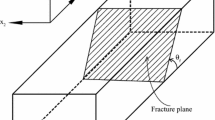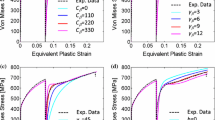Abstract
This paper is concerned with a formulation and statement of energy balance criteria during slow crack growth and at inception of catastrophic rupture in relatively high strength ductile metals. The phenomena of necking in a tensile test and slow crack growth in a uniaxially loaded, transversely cracked sheet are taken as models for a general, conceptual analysis. The various mechanistic criteria of crack instability that have been suggested are critically evaluated, in light of recent experimental data, through simple mathematical-physical examples. A more general energy balance criterion for ductile fracture is proposed which is consistant with experimental observations and which reduces to the classical Griffith theory (both conceptually and mathematically) in the case of purely elastic, brittle fracture.
Résumé
Cette étude traite d' une formulation et constatation du critére d' équilibre d' énergie pendant la croissance lente d'une fissure et le commencement d' une rupture catastrophique dans les métaux ductiles de grande resistance. Les phénomènes d'étroitement dans un essai de traction et croissance lente d'une fissure dans une feuille soumise á une tension uniaxiale et fissurée transversalement, sont utilisés comme modéles pour une analyse conceptuelle et générals. Les différents critères mécaniques de l'ínstabilités d'une fissure qui ont été jusque ici recommendés, sont critiquement evalués dans la lumière de récentes données expérimentales par de simples exemples physico-mathématic. Un critère plus général pour l'équilibre d' énergie d'une fissure ductile est recommendé qui se conforme avec les observations expérimentales et qui se réduit á la théorie classique de Griffith (tant en conception que mathématiquement) dans le cas d'une rupture par fragilité, purement élastique.
Zusammenfassung
Diese Abhandlung bezicht sich auf die Formulierung and Erklaerung von Energie-Gleichgewichts — Kriteria waehrend des langsamen Wachsens von Rissen und beim ploetzlichen Reissen relativ hoch belastbarer Metalle grosser Ducktilitaet. Die Erscheinungen, dass sich eine Einschnuerung waehrend einer Zerreissproble bildet und dass eine Bruchstelle langsam in einem einachsig beanspruchten Blech mit querlaufendem Riss waechst, werden als Ausgangspunkte fuer eine grundsaetzlich allgemeine Analyse verwendet. Die verschiedenen mechanistischen, bereits vorgeschlagenen Kriteria der Riss-Instabilitaet werden kritisch im Lichte experimentell gewonnener Daten an Hand einfacher mathematisch-physikalischer Beispiele gewertet. Ein allgemeineres Energie-Gleichgewichts-Kriterium fuer Ducktilitaetsrisse wind vorgeschlagen, das mit experimentellen Beobachtungen uebereinstimmt und das sich (sowohl begrifflich wie auch mathematisch) in den Faellen rein elastisch, sproeder Rissibildung auf die klassische Griffith Theorie reduzieren laesst.
Similar content being viewed by others
References
A. Griffith Phil. Trans. Roy. Soc. (London), Ser.A221163–198 (1921).
G. R. Irwin Fracturing of Metals, Am. Soc. Metals,Cleveland 147–166 (1948).
E. OrowanFatigue and Fracture of Metals, The Technology Press, MIT, and John Wiley, New York, 139–167 (1952).
E. OrowanJ.Appl.Phys., 26, 900–902 (1955).
D. Broek “The Residual Strength of Cracked Sheet and Structures,” Nationaal Lucht —En Ruimtevaart — Laboratorium, Rept.M.2135, Amsterdam (August 1964).
M. L. WilliamsProc. Crack Propagation Symp., Cranfield, 130–165 (1961).
S. R. Valluri, G. E. Bockrath, AIAA Fifth Annual Structures and Materials Conf. , Palm Springs, 132–138 and J. B. Glassco (April 1964).
J . L. Swedlow and M.L. “A Review of Recent Investigations into Fracture Initiation at GALCIT,” ARL Williams64–175, Office of Aerospace Research (October 1964).
S. R. Valluri “Fracture Under Biaxial Conditions in the Presence of a Crack,” presented at International Conference on Fracture, Japan (September 1965); to be published in Proc.
W. W. Gerberich Exp. Mech., 4,335–344 (1964).
J. L. Swedlow and W. W. Gerberich Exp. Mech., 4, 345–351 (1964).
Lynn Seaman “A Stress Criterion for Crack Growth,” presented at SESA Spring Meeting Denver, Paper No.947 (May 1965).
Additional references
A. E. TaylorAdvanced Calculus, Ginn & Co., New York, pp. 433–436 (1955).
J.R.Rice“An Examination of the Fracture Mechanics Energy Balance from the Point of View of Continuum Mechanics,” International Conference on Fracture, Sendai, Japan, Paper No. A-18 (September 1965); to be published in Proc.
G.E. Bockrath and J.B. Glassco “Fracture Toughness of High Strength Sheet Metal” ASM Western Metal Congress,Los Angeles (March 1963).
Author information
Authors and Affiliations
Rights and permissions
About this article
Cite this article
Havner, K.S., Glassco, J.B. On energy balance criteria in ductile fracture. Int J Fract 2, 506–517 (1966). https://doi.org/10.1007/BF00193689
Received:
Issue Date:
DOI: https://doi.org/10.1007/BF00193689




